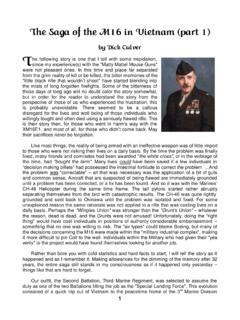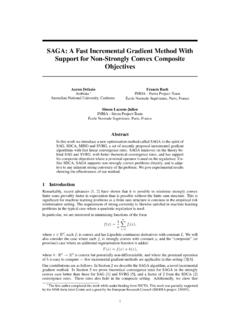Transcription of Tutorial to Jumpstart SAGA - Research Profiles
1 Tutorial to Jumpstart saga Dave Ensberg Yong Han Goh Marine Physical Laboratory Scripps Institution of Oceanography University of California, San Diego Email : . _ Table of contents 1. 2. 3. saga Jumpstart Part I setting up the parameter 4. saga Jumpstart PartII - how to input array shapes in saga for the forward model SNAP and 5. saga Jumpstart part III - running Annex A : Detailed description of 1. Introduction This Tutorial gives a quick introduction to saga to Jumpstart the new user on saga , but is not meant to replace the saga user manual. This Tutorial is broken up into three parts. The first part provides an understanding of the saga parameter file.
2 The second part discusses how to input receiver information (array shape) into the forward model SNAP (or SNAP3D) and a quick summary of the options available to do this. The third part explains the actual running of saga and how to plot results. The annex lists 7 Jumpstart examples which can be downloaded and run with saga . The first two examples are single frequency examples for a simple and fast introduction into running saga . The next three examples demonstrate MFP using 13 frequencies with a vertical line array (VLA). The last 2 examples demonstrate MFP with a horizontal line array (HLA).
3 Single frequency examples: - invert for tilt and range using 388 Hz (simulation) - invert for tilt and range using 388 Hz (real data from SWellEx96 Event S5 ) Multi-frequency examples: - invert for source range and depth (MFP) (simulation) - invert for source range and depth (MFP) (simulation) data generated by Kraken, field, and krakp and are imported to saga for processing - invert for source range and depth (MFP) real data from SWellEx96 Event S5. invert for source range, depth, array bearing and array bow (MFP) (simulation) invert for source range, depth, array bearing and array bow (MFP) (real data from SWellEx96 Event S5) 2. Setup 1. Download the and files to your saga directory ( /home/saga53).
4 2. Extract the file > tar xvf 3. Go through the Tutorial and try the examples! 3. saga Jumpstart Part I setting up the parameter file Refer also to saga manual Section 6. There are two parts to running saga . Part 1 is setting up the parameter file which is the input file for saga . Part 2 is the actual running of saga . In the saga parameter file there are 5 sections, blocks 1 - 3 and 5 are saga specific commands. The 4th block of commands is specific to the forward model that will be used in the saga run. A sample saga parameter file: 01) saga jump start example, data based on physical array (opt X) 02) c b W !
5 Options 03) 04) 2000 64 20 ! niter, q, npop 05) 0 ! px,pu,pm 06) t ! snap options 07) 2 100 ! freq max_no_modes 08) 49 388 09) 213.,0.,0.,0 ! water depth scatt(1),scatt(2),beta(0) 10) 0. 11) 12) 13) 14) 15) 16) 30 ! sediment thickness, r1, beta(1) 17) 1572. 18) 30 1593. 19) , , 1880. ! bottom r2 beta(2),c2 20) 0.,0. ! bottom shear beta(3) c2s 21) 60 ! source depth 22) 0 0 -21 ! rec depth 23) 24) 25) 26) 27) 1 !
6 Number of ranges 28) 2140 ! receiver range 29) 30) 3 ! nparm 31) 9 1 1000 5000 128 ! source range 32) 19 1 -10 10 128 ! array shape tilt 33) 8 1 10 90 128 ! source depth The first column of numbers is a line number. The line numbers are normally not present in the saga parameter file they are only here for reference so that it is clear which line is being discussed. The saga input parameter file is divided into 5 sections called blocks. The first 3 blocks, and the 5th block are for saga . The 4th block contains the forward model parameters.
7 Block I -- Title 01) saga jump start example, data based on physical array (opt X) Line 01) is the title for this file. It is not put on output plots but is put in the output file 'results'. If you keep the title current with the changes made in the file, the output file 'results' will list the updated title with the current results so you can keep track of the changes that were made and their effects. This line is referred to as Block I in the saga manual in Chapter 6. Block II -- OPTIONS 02) c b W ! options Line 02) are the options to use in this saga run.
8 saga has more than 50 options available, only a few are discussed here. See the saga manual for a complete listing of all the options. Two options should always be specified in saga . The first is the Observed Data Format. saga needs to understand the format of the input data. The 'c' option says the input data will be a covariance matrix. See Sect for details of this format. The second option is the Objective Function. Only certain objective functions work with each data type. In this case the default option for the covariance matrix is used. When a default option is used there is no need to specify it on the parameter line.
9 The default option for the objective function is the Bartlett power for each frequency is summed. The 'b' option specifies that the covariance matrix is normalized by dividing it with the sum of the diagonal. The maximum obtainable Bartlett power is slightly less than one ( depending on the noise in the data ). The 'W' option indicates to write the calculated data (using the baseline model) to the *.obs file. The format the data is written out in will be determined by the input data format parameter. In this example it will be written out as a covariance matrix. This line is referred to as Block II in the saga manual in Chapter 6.
10 Block III -- Genetic Algorithm Parameters ( 2 lines ) 04) 2000 64 20 ! niter, q, npop 05) 0 ! px,pu,pm Line 04 specifies the genetic algorithm population parameters niter, q, and npop. niter = 2000 = is the number of forward modeling runs for one population. In this example each population will be run 2000 times. q = 64 = is the Population size in bits. In this example 64 bits are used. npop = 20 = is the number of parallel populations to be run. In this example 20 populations will be run. It is best to only change the niter and npop parameters. The number of forward models run will be equal to niter multiplied by npop.









